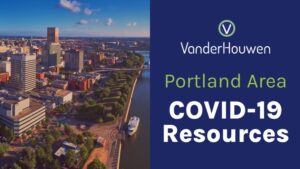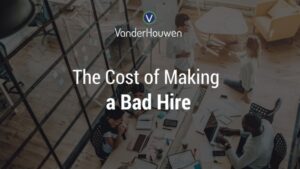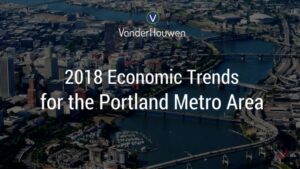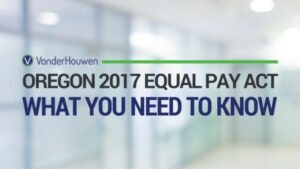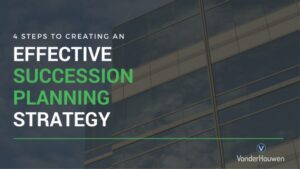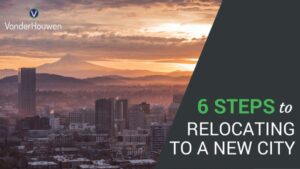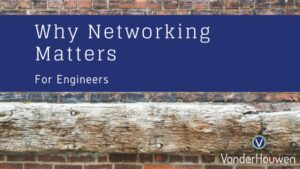2018 Economic Trends for the Portland Metro Area by Christian Kaylor, OED
This 2018 economic forecast is written by Portland Economist Christian Kaylor. Christian Kaylor is a Workforce Economist for the Oregon Employment Department, specializing in the Portland area. He provides data analysis and advice relating to the Portland economy to local businesses, business associations, and government agencies to facilitate intelligent decision making.
Those of us who live in Portland have noticed tremendous changes in the economy in recent years. The economy itself is booming, and with that has come an influx of activity—like younger adults with college degrees who continue to move to Portland in greater numbers, seeking affordability and a higher quality of life. The job market has become increasingly competitive, especially in the technology, engineering, and finance sectors. Portland has become an attractive market—for job seekers, employers, and businesses alike.
So, are these trends here to stay? What impact are these changes having on our population in terms of income, education, etc.? As we head into 2018, here are 3 things you should know about Portland’s economy:
1. The Portland economy is booming
Since the worst of the recession in 2010, Portland has enjoyed some of the strongest job growth in the United States. The Portland region has created 207,000+ jobs over the last 8 years—which is a 21% job growth since 2009. In comparison, jobs in the United States grew by 13% over the same time period. As jobs have grown, incomes in Portland have increased dramatically as well. The median household income in the city of Portland was $62,127 in 2016. Adjusted for inflation, this means that Portland’s average income has increased 20% since 2016. To put that increase into context, Portland was the 18th wealthiest city in America among the 50 largest US cities in 2011—so, Portland is roughly in the middle of the pack among large US cities. Today, Portland is the 11th wealthiest large city in the US, between Boston and Denver. Not only has Portland’s economy increased significantly since the recession, it’s nestled comfortably between other major cities in terms of wealth. That’s significant.2. Lots of people are moving to Portland, especially younger adults with college degrees
Our economic growth doesn’t exist in a bubble. As Portland continues to grow, it’s become an appealing location for young transplants. In fact, the number of working-age college graduates in Portland has grown dramatically over the last few years. The Portland metro area, specifically, is the sole driver of growth in college-age workers in the state of Oregon. Since 2010, 87% of the entire increase of college graduates in the workforce has been in just the Portland metro area. So, is our economy booming because people are moving to our city, or are people moving to our city because the economy is booming? Well, it’s both. The rapid increase in the number of college graduates in the workforce is both a result of the strong economy and a factor of that growth. Portland has long had a reputation for its great quality of life, which makes it a major attractor for younger professionals looking to relocate. The number of adult residents in the city of Portland, under age 65, has grown by 49,019 from 2010 to 2016. That’s an incredible increase of 32% in just six years. And, this makes Portland the sixth fastest for population growth in this demographic among the 50 largest US cities. To compare, Portland is growing twice as fast as Las Vegas and three times faster than Milwaukee in this demographic. A contributing factor to a great quality of life is a stable income—and Portland’s job market has become a major lure for young adults. Higher wage firms depend on the availability of professional talent to grow, and that professional talent is in serious demand. Some of the fastest job growth in the Portland area has been in professional businesses: software, engineering, medical research, and finance. Portland’s attractiveness to younger adults means that these companies have been able to find the skilled workforce they need in order to be successful. Portland’s new, better educated workforce will be a fundamental driver for economic growth in Portland for many years to come. Better educated workers are less likely to lose their jobs in a recession. Similarly, businesses looking to expand or relocate will be drawn to Portland’s well-educated workforce.3. Portland’s economic growth has been unevenly distributed
There’s an important consideration to make when we look at economic growth in Portland—its distribution hasn’t been particularly even. The rapid economic growth Portland has enjoyed has been driven by two correlated factors: lots of new high wage jobs and lots of new folks with a high level of technical skill to fill those positions. This means highly educated, highly technical white collar professionals. The unintended side effect of this economic growth has made Portland a place of increasing income inequality. Let’s look at an example. The average wage for a full-time worker living in West Portland is $102,209 a year. That’s the highest income community of its size in the state of Oregon. Ironically, the lowest income community in Oregon is also in the city of Portland. The average wage for a full-time worker living east of 82nd in the city of Portland is just $44,328 a year. That makes East Portland the lowest income community in the state of Oregon. And although East Portland has been relatively lower income for many years, the income gap between East Portland and the rest of the city has grown dramatically over the last 10 years. For example: in 2006, the household income gap between East Portland and the rest of the city was just $17,000. Today, that income gap has doubled to $36,000. Excluding East Portland, household incomes have grown 25% in the last 5 years. But in East Portland, there has been no increase in household incomes in the last 5 years. So what’s causing this deep discrepancy? There are two drivers behind the increasing income gap between East Portland and the rest of the city. First, the impressive wage growth in Portland has gone primarily to higher educated professionals. So, although most of the city has seen large growth in this demographic, East Portland has not. Second, most of the higher wage businesses are located in either Washington County or the downtown urban core. East Portland is ethnically diverse, relatively less educated, and geographically distant from the high wage firms in downtown Portland. So, while Portland’s economy continues to rise, it’s important to keep these considerations in mind. Portland’s economic growth means great things for our city—more jobs, a bustling community, and higher wages. But with this spike in growth has come an increase in inequity in other parts of our community. As we head into 2018, let’s continue to assess how our economy—and our job market—evolves.Looking for more insight into the Portland job market? Check out VanderHouwen’s 2018 Salary Guides for IT/Engineering or Accounting & Finance roles.















































